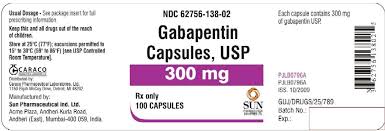Gabapentin may also be used to treat other nerve pain conditions (such as diabetic neuropathy, peripheral neuropathy, trigeminal neuralgia) and restless legs syndrome.
Diabetes can harm your nerves. That damage, called neuropathy, may be painful. It can happen in several ways, and they all seem to be related to blood sugar levels being too high for too long. To prevent it, work with your doctor to manage your blood sugar. You may hear your doctor mention the four types of diabetes-related neuropathy: peripheral, autonomic, proximal, and focal.
Gabapentin dosing for neuropathic pain: evidence from randomized, placebo-controlled clinical trials.
BACKGROUND:
 Pain is one of the most common reasons for seeking medical attention, and neuropathic pain is among the most common types of pain. Despite its prevalence, neuropathic pain is often underrecognized and inadequately treated. Many cases are refractory to the medications traditionally used for pain, such as nonsteroidal anti-inflammatory drugs. Tricyclic antidepressants are considered first-line agents for neuropathic pain, but their use is limited by unwanted side effects and a risk of cardiovascular mortality.
Pain is one of the most common reasons for seeking medical attention, and neuropathic pain is among the most common types of pain. Despite its prevalence, neuropathic pain is often underrecognized and inadequately treated. Many cases are refractory to the medications traditionally used for pain, such as nonsteroidal anti-inflammatory drugs. Tricyclic antidepressants are considered first-line agents for neuropathic pain, but their use is limited by unwanted side effects and a risk of cardiovascular mortality.
OBJECTIVES:
The goals of this article were to review data on the efficacy and tolerability of gabapentin in the treatment of neuropathic pain in adults and to determine the optimal dosing schedule.
METHODS:
Randomized controlled studies of gabapentin for neuropathic pain were identified through a search of PubMed and MEDLINE from 1966 to the present using the search terms gabapentin, randomized, placebo, and pain. Abstracts of identified articles were screened for study size (>100 patients per treatment arm) and use of appropriate efficacy measures. A separate review based on information provided by the manufacturer of gabapentinaand clinical trial Web sites was conducted to ascertain whether there had been any other relevant industry- or government-sponsored trials. The manufacturer provided additional unpublshed study data.
RESULTS:
Data from 5 randomized, placebo-controlled trials were included in the review, 1 of which has not yet been published. Gabapentin was effective in the treatment of painful diabetic neuropathy, postherpetic neuralgia, and other neuropathic pain syndromes. It relieved symptoms of allodynia, burning pain, shooting pain, and hyperesthesia. Adverse effects were typically mild to moderate and usually subsided within approximately 10 days from the initiation of treatment. Based on available data, it appears that treatment should be started at a dose of 900 mg/d (300 mg/d on day 1, 600 mg/d on day 2, and 900 mg/d on day 3). Additional titration to 1800 mg/d is recommended for greater efficacy. Doses up to 3600 mg/d may be needed in some patients. The effective dose should be individualized according to patient response and tolerability.
CONCLUSION:
At doses of 1800 to 3600 mg/d, gabapentin was effective and well tolerated in the treatment of adults with neuropathic pain.